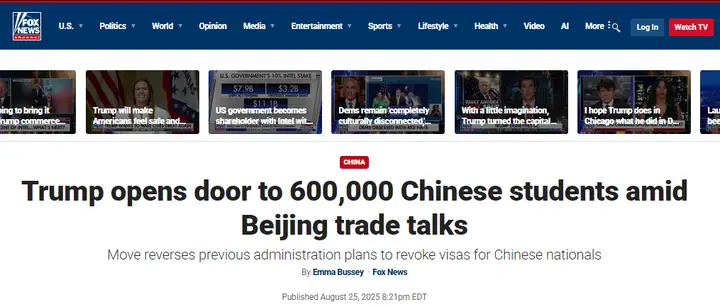The Trump administration announced a welcome for 600,000 Chinese students to study in the U.S. What are the reasons behind it?
Answer 1:
It’s a perfect example of “showing up with milk after the child has already died.” Universities have been through the wringer: funding was cut, lawsuits were filed, visas were denied. As a result, widespread funding issues emerged—even top universities are laying off staff en masse, reducing graduate admissions, and even closing entire departments. The University of Chicago had internal conflicts: while humanities programs saw major cuts, a professor in the Classics Department attacked the East Asian Studies Department for still planning to enroll students. It ended with neither department admitting anyone. Everywhere you look, it’s chaos—the very foundation is shaking. Now, after all that damage, they say they want to recruit students again? Who’s going to apply? Where will they come from? With visas being denied arbitrarily, deportations happening, and unfriendly sentiments being stirred up, who would dare to come? They smashed the reputation of American higher education to please the MAGA crowd, and now that they see the losses, they want to pretend nothing happened. Did they think there was a save/load button for real life?
Answer 2:
American universities are in a desperate admissions crisis—what else? On average, an international student directly contributes about $80,000. For 600,000 students, that’s nearly $50 billion. Remember that “gold card” scheme Trump promoted? How many did he actually sell? And each student living in the U.S. probably spends at least $5,000 a year—is that not money? Of course, at the national level, this amount isn’t huge. But for the American private education industry, it’s a significant figure.
Answer 3:
Trump is treating the U.S. like a sandbox game.
He just loads a previous save whenever he feels like it and overwrites the current progress.
The only problem is, these NPCs actually have memory… what a headache.
Answer 4:
On one hand, they’re planning to cancel OPT and H1B; on the other, they’re blocking F1 visas for Chinese students left and right, and now they’re saying they welcome Chinese students? The smell of Myanmar-style telecom fraud is practically leaking through the screen.
Answer 5:
The return on investment for studying in the U.S. is extremely low now. It used to be: spend $50K over two years, then land a coding job making over $100K a year. Now, it costs $80–100K for two years, and it’s nearly impossible to get a coding job. AI is hitting coding jobs hardest. All major tech companies have frozen hiring. I expect more layoffs this year too.
Answer 6:
In the UK, the visa duration is longer than the study period. For example, a one-year master’s gets a year and a half visa; a three-year undergraduate degree gets over three years. In the U.S., the visa is shorter than the study period. PhDs usually take 4–5 years, but most students get only 1–2 years on their first visa. They have to renew midway—and renewal can fail. What happens if it fails? You’re done. In 2020 and 2021, I heard of several peers who couldn’t continue their studies because the U.S. denied their visa renewal. They were forced to drop out and reapply. Just one incident like that is devastating—not only for the student, but for all potential applicants. That’s why applications to the UK surged during the pandemic—thanks to the U.S. At least in the UK, you don’t have to worry about being forced to quit because of visa issues. Those liberal arts students from wealthy families may not lack money, but they lack time. If they go to the U.S. for two years and then get told their visa isn’t renewed, and they have to reapply and start over—who would put up with that? Repeating freshman year, repeating a master’s, repeating a PhD—who would willingly suffer that?
Answer 7:
Chinese students make up a quarter of all international students worldwide. The main destination is the U.S. In recent years, U.S. government restrictions on international students have reached terrifying levels. Even if they loosen up now, it’s mainly for humanities majors. Humanities graduates can’t stay in the U.S., and when they return, both national and local employers in China are reluctant to hire them. Another major blow is the refusal of Chinese civil service and state-owned enterprises to hire returnees. Overall, there’s no hope left in studying abroad.
Answer 8:
The setup to prevent international students from staying and working after graduation is already complete. The new H1B rules have been passed: the minimum salary level to participate in the lottery is now almost as high as a full professor’s salary at a public university. Except for a small number of coders, most OPT holders won’t even meet the threshold to enter the H1B lottery. Proposals for F1, I94, and OPT are also under review, basically cutting off all alternative paths for graduates to draw for H1B. So aside from PhDs and a few scholarship-funded master’s students, the rest are just cash cows—pure profit for the U.S., with no way to earn back their tuition.
Answer 9:
Trump has masterminds behind him. This policy brings five victories for the U.S.:
- If any top talent among the 600,000 stays, it benefits the U.S.
- China loses its top talent.
- For the average students, they’ll be fed a diet of “democracy,” “freedom,” feminism, LGBT rights, environmentalism, animal rights, etc.—so when they return to China, they’ll sow social chaos.
- Large numbers of int’l students bring revenue to related industries.
- One simple policy achieves four victories—that’s the fifth victory!
Answer 10:
Isn’t it obvious? It’s the Myanmar-north model. Once you land, ICE shows up. If your family doesn’t pay $1 million, they inject you with heroin. If they don’t pay $10 million, you don’t get released. 600,000 students means 6 trillion—that’s one-sixth of the national debt paid off right there.





Yo, feeling lucky? Gave luckyluxecasino a shot, and you know what? It wasn’t terrible. Gamble responsibly, but hey, maybe you’ll strike gold! luckyluxecasino